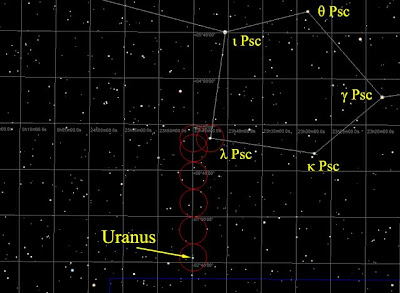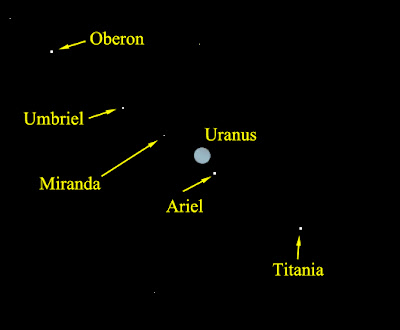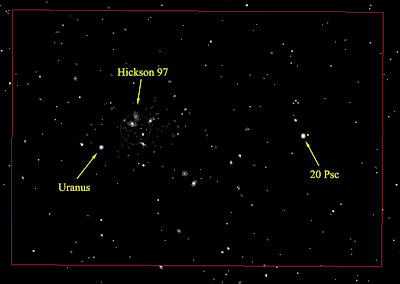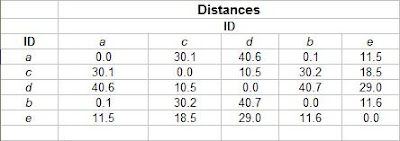previous post, while I was processing the image I noticed a number of fuzzy objects to the South-West of the planet that looked very much like galaxies. I did a quick search and found out that Uranus was just few arcminutes away from the Compact Group of Galaxies (CGC) named Hickson 97. The presence of a planet right beside a very distant group of galaxies convinced me to take a longer exposure. The night of July 24 looked promising so I went for a 1h 42min 30sec total imaging time (my camera battery died before the end of the 1h 45s planned session...). I kept the exposure of individual subframes pretty short (30 sec) to minimize the adverse effect of light pollution. Speaking of which, I was really impressed with the darkness of my backyard. That night I could see all the stars of the Little Dipper with the exception of the dimmest, η UMi (mag +4.95) so the limiting magnitude of my skies must have been about +4.8: not bad for an urban location!
Regardless of how "dark" my location is, finding Uranus these days is not that easy. Currently Uranus is about 30 degrees high (at culmination) in Pisces, close to the border with Aquarius and Cetus:

Its apparent magnitude (+5.8), the low altitude and the fact that it sits in a region of the sky deprived of bright stars contribute to the challenge of finding this interesting planet. So how do I find Uranus? I use the only method that cannot fail: star-hopping. I have to admit that star-hopping with a 10" f/4.7 reflector is quite easy. The limiting magnitude I can reach with direct vision is probably around +11 or +12. I still have to find a single low power field of view with my scope that does not contain any star that dim. I usually begin the hop from a naked eye star that is not too far from the target. After pointing the scope towards such a star, I look into the finder hunting for dimmer stars that are closer to the target. Then I launch Cartes du Ciel on my laptop and superimpose the field of view provided by a 25mm Plossl eyepiece (about a degree). I place a series of circles (field-of-views) that go from the beginning of the hop to the target (typically a star visible in the finder), making sure I follow the directions provided by Declination and R.A. Here is the hop that led to Uranus:

The reason why I lay the field-of-view circles in the directions of the celestial coordinates is simply because my telescope is attached to an equatorial mount which moves along declination and R.A. If I had an alt-azimuth mount, I would follow the directions altitude-azimuth instead. Star λ Psc (the start of the hop) is magnitude +4.5 and I could not see it naked eye from my backyard (the atmospheric extinction is significant at an altitude below 30 degrees). I could see α Peg (Markab, mag.+2.5), instead. After centering Markab in the 6x30 finder I was able to find λ Psc.
The arrangement of the moons on the night of the 24th was quite favourable:

Ariel was too close and Miranda was just too faint, but the other three were within reach. As I mentioned at the beginning of this post, I took a 1h 42min 30sec total exposure of the region around Uranus. I used a Baader coma corrector and an Orion Starshooter autoguider to minimize aberrations and star trailing. The camera gain was set to ISO1600. Here's the processed image with a close-up of the Uranian system. As you can see I was unable to get all four main moons, but between this image and the one I took on July 21 I did manage to image all of them.
It is also interesting to see how much Uranus moved against the background stars from July 21 to July 24.
Although I was interested in capturing the moons again, my primary focus was on Hickson 97 and other fuzzies:

that were barely visible in my previous (shorter exposure) image:
So here's the processed image without the inset.
If you look carefully you will notice a number of faint deep sky objects in this image.
Here's an annotated, enhanced version of the previous image.
Inset 1 shows Uranus and its moons as it's been discussed before.
Inset 2 shows Hickson 97 as imaged from my telescope (for comparison an image of the same region from the STScI Digitized Sky Survey is shown in the bottom right corner). Hickson 97 is an example of Compact Group (CG) of galaxies. CGs are defined as "small systems of several galaxies in a compact configuration on the sky" (Hickson, 1997, Introduction). CGs challenge Astronomers in many ways. For example, when the red shift of the first CGs were measured at the beginning of the 60ies, it was found that in some cases one of the galaxies had a redshift quite different from that of the other members. What seemed peculiar was the fact that the probability of finding a completely unrelated galaxy (different redshifts imply different distances from Earth) overlapping with a CG was supposed to be very low and yet at least three examples of CGs having a galaxy with different redshift within them had been found . To complicated matters even further was the fact that Halton Arp, one of the most prominent experts in Galactic Astronomy and author of the famous Catalogue of Peculiar Galaxies, proposed that the enormous redshift of quasars was not due to the expansion of the universe. Instead, according to Arp, quasars were physically related to much closer galaxies which, in turn, showed red shift anomalies. Arp published an interesting albeit controversial book on the subject entitled Quasars, redshifts, and controversies. The work of Hickson devoted to generate a much more homogenous list of CGs helped clarify that the galaxies with discordant redshifts were in all likelyhood the result of projection alignments and were not physically related to the CGs they were superimposed to. For more information please refer to the very readable review by Hickson himself available online. Hickson 97 is about 300 million light-years away and consists of five galaxies identified with the letter a, b, c, d and e (data from the Principal Galaxy Catalogue):
| Component | Dimensions (arcminxarcmin) | Integrated Magnitude | Galaxy Type |
|---|---|---|---|
| HCG 97a | 1.6'x0.8' | 14.04 | S0 - Lenticular |
| HCG 97b | 1.2'x0.3' | 15.72 | Sc - Spiral |
| HCG 97c | 1.0'x0.5' | 14.98 | Sa - Spiral |
| HCG 97d | 1.7'x0.8' | 14.64 | E1 - Elliptical |
| HCG 97e | 0.5'x0.3' | 16.65 | S0a - Lenticular |
My image shows all the components of Hickson 97, plus a couple of smaller galaxies, one of which I could not identify.
Inset 3 shows two fairly bright galaxies ("bright" here is a relative term...) as compared to Hickson 97. PGC 72461 in particular is a mag.+14.54, 1.1'x0.6' elongated lenticular galaxy (S0 class) with a bright core. PGC 72457 is a smaller 0.9'x0.7' spiral (Sb) of mag.+15.06. The image seems to indicate a hint of a spiral arm, but it is difficult to distinguish actual details when the levels are stretched to the limit.
Inset 4 shows a region with three faint galaxies of magnitudes +15.8 (PGC 196678), +16 (PGC 3080162), +17.22 (PGC 1086503) and a pair of galaxies, PGC 72432 and PGC 72433 of magnitude +16.56 and +16.12, respectively.
Scattered througout the entire field of view I was able to identify at least 19 more faint galaxies. Here's the complete list in order of apparent magnitude including the component of Hickson 97 and the galaxies in inset 3 and 4. In total the camera was able to detect 28 galaxies! The distance of each galaxy was calculated from the radial velocity as provided by the Principal Galaxy Catalogue (PGC) using the well-known formula d = H0 x v, where d is the distance in millions of light-years (Mly), H0 = 74(km/s)/Mpc is the Hubble constant and v is the radial velocity in Km/sec as deducted from red shift measurements. The PGC provides also the apparent major and minor axis of each galaxy in arcminutes. Knowing the distance and the apparent size, it is possible to estimate the actual size of a galaxy. In the following table, the size (intended as the average radius of the galaxy) is given in light years.
| PGC# | Integrated Magnitude | Radial Velocity | Distance (Mly) | Size (ly) |
|---|---|---|---|---|
| 72408 HCG 97a | 14.04 | 6922 | 305 | 142000 |
| 72461 | 14.54 | 6757 | 298 | 95000 |
| 72404 HCG 97c | 14.64 | 6239 | 275 | 135000 |
| 72409 HCG 97d | 14.98 | 6001 | 264 | 77000 |
| 72457 | 15.06 | 6379 | 281 | 74000 |
| 72430 HCG 97b | 15.72 | 6924 | 305 | 106000 |
| 196678 | 15.80 | 6876 | 303 | 52000 |
| 196723 | 15.82 | 6672 | 294 | 60000 |
| 3080162 | 16.00 | 6988 | 308 | 45000 |
| 1099772 | 16.08 | 6932 | 305 | 53000 |
| 196716 | 16.12 | 9179 | 404 | 59000 |
| 72405 HCG 97e | 16.65 | 11894 | 524 | 43000 |
| 1091588 | 16.72 | 11894 | 524 | 61000 |
| 1092309 | 16.77 | 7240 | 319 | 37000 |
| 196644 | 16.86 | 22187 | 977 | 85000 |
| 1088838 | 16.96 | 7182 | 316 | 55000 |
| 1086503 | 17.22 | ? | ? | ? |
| 1100745 | 17.24 | 6459 | 285 | 33000 |
| 1084361 | 17.24 | 29447 | 1297 | 113000 |
| 1097356 | 17.50 | 7591 | 334 | 29000 |
| 1092236 | 17.56 | ? | ? | ? |
| 1092931 | 17.65 | 6684 | 294 | 26000 |
| 1088714 | 17.65 | ? | ? | ? |
| 1099340 | 17.77 | 7348 | 324 | 28000 |
| 1092607 | 17.77 | ? | ? | ? |
| 1092439 | 17.86 | ? | ? | ? |
| 1091291 | 17.92 | ? | ? | ? |
| 1099417 | 17.95 | ? | ? | ? |
| 1096772 | 17.96 | 40995 | 1806 | 160000 |
It is interesting to see that the galaxies of Hickson 97 are among the brightest in the list. The reason is that at an average distance of about 300 million light-years they are relatively close (as compared to the other galaxies). They are also large galaxies: component a, for example, is about 140,000 light years across, about 40% larger than the Milky Way. Components c and b at 135,000 and 106,000 light-years across are also respectable. To find the actual size of these galaxies is simply a matter of geometry: the PGC Catalogue provides their angular sizes. The distance is known from their radial velocity and the Hubble's Law, as explained above. So the actual size in light-years is the product of angular size (in radians) and distance (in light-years).
About 16 of the 28 galaxies shown in the image are at about 300 light years away from us. I was not able to find any information as to whether these galaxies belong to some larger structure, but, given their distance, density and location, I am guessing they belong to the Perseus-Pisces supercluster. The rest of the galaxy in the list is farther away. The three farthest from us seem to be 977 million (PGC 196644), 1.3 billion (PGC 1084361) and 1.8 billion (PGC 1096772) light years away!
I am sure these are the three most distant objects I ever imaged. I find quite exciting that a few photons which had travelled across the Universe for a couple of billion years ended up being converted in electic current inside my camera!
Finally the last question I wanted to answer was what the sky would look like from a planet located in one of the Hickson 97 galaxies. How big would the other components of the Group appear in the night sky of a planet located in one of those galaxies? Geometry comes to the rescue. Knowing the distance from Earth and the celestial coordinates (RA and Dec) of each of the Hickson 97 galaxies, with the help of some trigonometry it is easy to calculate the relative distance between each pair. The following table provides the distance (in Mly) of each galaxy from the others:

Where distances are given in million of light years. The content of each cell provides the distance between the component on the row and the component on the column. For example, the distance between component a and component b seems to be only 100,000 light years which is less than their respective sizes! If that's the case the two galaxies must exert a significant gravitational pull on each other and orbit around their common centre of mass like a gargantuan dumbbell. The other components seems to be located between 10 and 40 million light years away from each other, which means that Hickson 97 is about 4 times bigger than our own group of galaxies, the Local Group. It is interesting to note that the Local Group would look like a bit smaller than Hickson 97 if seen from one of the component of Hickson 97 itself, with the Milky Way and the Andromeda galaxy replacing the roles of component a and b (although not that close to each other). I guess that helps put things in perspective! But let's go back to the original question which was: what the other galaxies of Hickson 97 would look like in the night sky of a hypotetical planet located around a star of component b, say? Knowing the apparent size of each galaxy and knowing their mutual distance it is easy to calculate how big they would look like from each other. It turns out that component a would span about 60 degrees across as seen from component b and it would look brighter than the Milky Way. Imagine the fun astronomers of component b must have when the sky is clear! The other galaxies would be between a tenth and half a degree across, probably very similar to our familiar Messier galaxies. The night sky from a planet in component a would be very interesting as well, since component b would span a little less than 50 degrees.
One last observation. In my image there is one planet, stars and galaxies. Light takes about two and a half hours to get to Uranus, many years to get to the stars (20 Psc, the brightest star in the image, is about 290 light years away), 300 million years to get to Hickson 97 and more than a billion year to get to the farthest galaxies captured in the image: that's one handy way of sizing the Universe!
The next table summarizes the

No comments:
Post a Comment